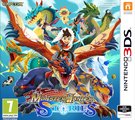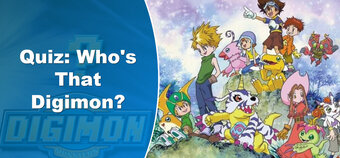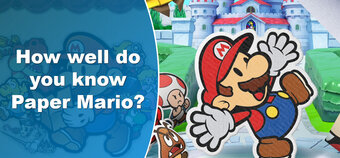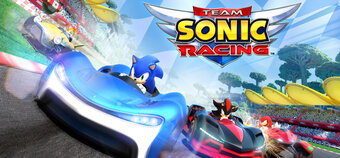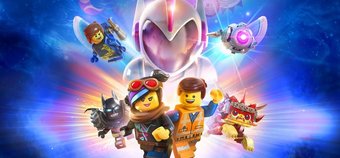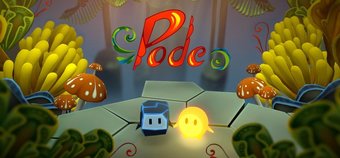Find a friendly monster, team up together, pit yourself against wild monsters all across the world, and set out on the adventure of a lifetime together. Monster Hunter Stories may not win any awards for originality in terms of its concept, but it's a game that gets almost everything right in terms of execution. Offering a Pokemon, or Ni No Kuni alike role playing game on the 3DS, Monster Hunter Stories may be a huge departure from the usual, multiplayer centric, button mashing Monster Hunting games, but it's one that deserves a place in every 3DS owner's collection.
Set in a gorgeously cel shaded land, Monster Hunter Stories tells the tale of three young adventurers - Lilia (the adventurous girl), Cheval (the quiet boy) and you, playing as a male or female character of your own creation. Part of a village that treasures the bond between human and monsters, you begin the game on a quest alongside your three friends, as you scale a mountain in an attempt to find your very own monster, or "monstie" as the game dubs them, hoping to make it your partner. However, no sooner have you returned to your village than disaster strikes. Out of nowhere, a mysterious dark mist covers the town, and a huge dragon-like creature known as a Narcaguca emerges. Destroying several buildings in the village before you can finally send it on its way, you soon discover that there's a reason for the monster's unusual behaviour - a dark power known as the Blight has been spreading across the land, infecting both the monsters and land.

Some monsters can even fly...
As the hero of the piece, it's up to you to figure out where the Blight is coming from, and put a stop to it on a heavily story driven quest - but you won't be doing it alone. After passing an initiation test, and finding a Monstie of your own, you'll become what's known as a Rider - a human that shares a special kinship with a monster (or 200, which is the maximum you can store). And it's this that's at the heart of Monster Hunter Stories' battles, world, and much of its gameplay.
Rather than catching monsties you find in the wild like Pokemon, you'll instead have to keep an eye out for Monster Dens as you travel the world, heading into the cave-like entrances whenever you see them. After battling a few enemies inside, you'll find yourself coming face to face with the monster's nest, where it's up to you to simply pinch an egg. If you're lucky, you'll find a nest with no-one guarding it - if you're not, you may have to go through a pretty tough boss fight before you get your hands on the prize. Regardless of how much you have to work for it though, the same catch still stands, as when you first pick your egg up, you won't have a clue what's inside. While you can press A again to rummage round and pick a different one, even this is a decision wraught with danger - switch the egg over too many times, and you may attract the attention of a rather angry, and powerful monster, who's none too chuffed about your messing around with its nest... Really, all you have to go on is the colours/markings on the egg, and any comments your cat companion, Navirou, may make (he has a nose for these sort of things, you see). After making your decision, it's back to the village as fast as you can manage, to take it to the stables, hatch it, and discover your new partner.
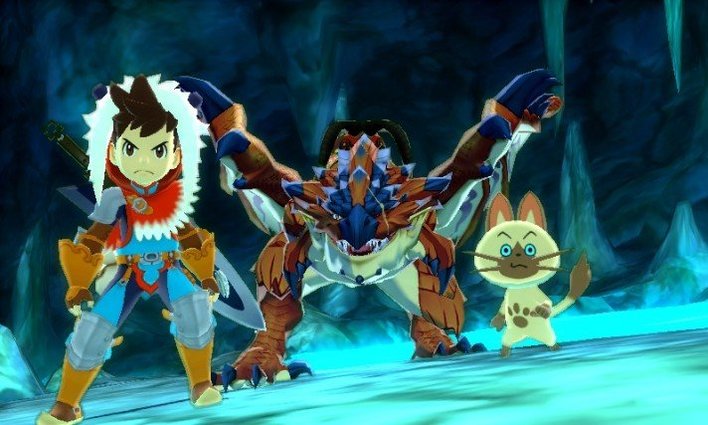
This is your war face
With over 60 different types of monsters to find (and the ability to give a nickname to each), Monster Hunter Stories is a game with that "gotta catch 'em all" appeal in spades, and even if you're in the middle of a really important story quest, it can be hard to resist the urge to nip into any Monster Dens you find, as you never know quite what awaits you inside. What perhaps differs a little is how they fight alongside you in battle. In a radical departure from the Monster Hunter norm, Stories actually uses classic role playing game style turn-based battles, as both man and beast take on the world's enemies together.
Rather than having a complex system of moves, Monster Hunter Stories instead uses a really simple rock-paper-scissors system. Each character, whether human or otherwise, knows three basic attacks - power, technical, or speed, with each being strong against one, and weak against another (so, power is strong against technical, but weak against speed). With your Monstie choosing his moves for himself, all you have to do is try and choose a move that'll give you the upper hand against the enemy. Luckily, most enemies you'll meet have a pretty one track mind, tending rather strongly towards just the one type of move - so Velociprey, the game's Velociraptor alike will use speed attacks probably getting on for 90% of the time - meaning it's simply a case of trying to remember what each enemy is likely to do.

Who knows what this beastie might do?
Beyond your bog standard moves, you've got a range of other abilities in battles that make things even more interesting. First off, both you and your Monsties can use a variety of special moves, outside the rock-paper-scissors norm, which let you mix things up a bit. Some have elemental effects (like a fireball), others heal either you or your Monstie, while others still let you analyse the strengths and weaknesses of your foe (which can be really, really handy). Much like Pokemon, too, you can switch your Monsties out during battle - so if you're coming up against an enemy who uses mostly power attacks, and your Monstie prefers to use technical moves (which is weak against it), then you can swap it for a Monstie that's more likely to use the right sort of moves.
Rather than bogging itself down in reaction based rubbish, Monster Hunter Stories has one of the smoothest, simplest, and most easy to understand battle systems out there, and one that makes almost every battle a pleasure. It's a system that also places a huge importance on the bond between you and your monster. As you and your buddy battle, you'll start to fill a Kinship gauge, with the gauge filling quicker if you show you're working together really well - like both choosing to exploit a monster's weakness in the same turn. Once fully charged, your Monstie will invite you to hop on its saddle, and take on your foe together, as your powers combine to make you a faster, tougher, and harder hitting duo. Riding your Monstie also gets you access to an uber special kinship skill, which dishes out tonnes of damage by default - but you'll want to hold off at least a little bit first, as exploiting your enemy's weakness while riding your Monstie will charge your kinship skills even further, for devastating effect. Even this - your most powerful move - isn't always serious though. One of our monsters, the seemingly clumsy (and somewhat bulky) Aptonoth, a big grey dinosaur with a rather big club on his head, uses a move called "Slip and Slam", where he tears towards the enemy, only to slip on a misplaced banana peel, before landing on top of them backside first...

Navirou is also quite the character
There's so much to like about the battles in Monster Hunter Stories, and the way your monsters work together with you. Like most role playing games, both you and your monsters have a levelling system, getting stronger the more experience they earn. Unlike most games, the XP you earn in battle is shared between your entire party, with both you and your monsters earning the same amount of XP, even if they weren't used in battle, making it easy to add a brand new character to the team, and level them up to same rank as everyone else.
It's also a game that's forgiving. Along with being able to have a party of up to five monsters (only one will fight alongside you at a time, but you can switch them out when their health gets low), you also have three hearts to use up. If you or a Monstie should fall in battle, it doesn't actually really matter all that much so long as you have one of your three hearts remaining - if you do, you'll simply get straight back up, and use up a heart to carry on the battle with your health fully restored. Even running out of hearts won't mean you lose too much progress, as you'll usually just get to restart from outside the last dungeon you were in - although the only way to restore your hearts is to return home and rest.
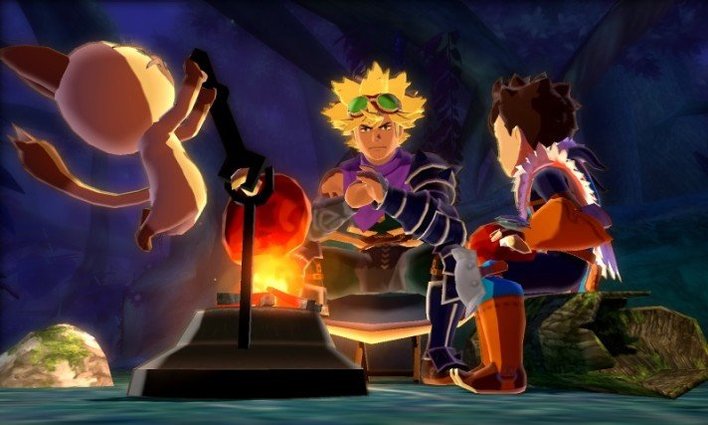
You'll meet an eclectic cast of characters along the way...
Though Monster Hunter Stories may be a heavily story driven game, with many a quest to complete, and a plot that'll take you to all corners of the game's world, there's plenty to do outside of the main plot too. A bulletin board in town offers a range of side quests and jobs for you to take on (many of which are repeatable, making them an easy source of the game's currency), whether you're helping a couple who've become trapped in a cave by a Velocidrome (a big, blue velociraptor type thing that seems to have stolen Yondu's head gear), or showing a soldier a herbivore egg (even if the game does annoyingly write it as "an herbivore"). You can also choose to upgrade your weapons rather than buying brand new ones, adding the various herbs, rocks, plants and bones you've scavenged out on the field to your sword to make it a heck of a lot stronger.
However, while there's so much to like in Monster Hunter Stories, there is at least one area the game disappoints, and that's in its performance. Whether exploring the game's world, or trudging through your home village, there's some noticeable slowdown and judderiness here, as the game pushes the 3DS to, and sometimes slightly beyond, its limits. While we should note we're playing on an original 3DS XL, rather than the upgraded new 3DS/2DS, we've heard that the performance is similar on both old and new consoles, making this a bit of a disappointment, if nothing else.
Still, with that "just one more battle" appeal in spades, 60 "Monsties" to collect, an epic story to take in, a cartoon styled world to explore, and a sense of humour to boot, Monster Hunter Stories is one of those games you'll keep coming back to.Channeling the spirit of bonafide classics like Ni No Kuni and Dragon Quest, Monster Hunter Stories is quite simply one of the best role playing games on the 3DS.
Format Reviewed: Nintendo 3DS


